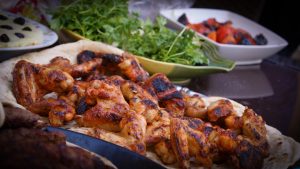Try This Easy Nutrition Tip To Help Heal Your Joint Pain From The Inside Out
 You’re doing everything you’re supposed to be doing. Seeing your chiropractor regularly, doing your at-home rehab exercises, eating well, and getting eight hours of shut-eye per night. Yet, your injury just doesn’t seem to be healing. You still have a lot of joint pain and let’s not forget about those mobility issues.
You’re doing everything you’re supposed to be doing. Seeing your chiropractor regularly, doing your at-home rehab exercises, eating well, and getting eight hours of shut-eye per night. Yet, your injury just doesn’t seem to be healing. You still have a lot of joint pain and let’s not forget about those mobility issues.
What gives?
We need strong and flexible joints to allow us to perform an array of movements. Everything from throwing a ball, running, skiing, and even more precise movements like playing a musical instrument. The strength and mobility of a joint is dependent on its ligaments, tendons and cartilage.
The missing piece to your rehabilitation program is quite likely nutritional.
As athletes, we tend to put a lot of emphasis on taking care of our muscle tissue when it comes to diet and specifically protein consumption. You make sure you get those BCAAs in during your long workouts and your whey protein shake within the touted “30 minute window” after your training session.
Although these supplements do have a lot of evidence to support their usefulness in sport nutrition, they do not include the crucial ingredients for joint health and repair.
When it comes to our connective tissue (ie., bones, ligaments, tendons, cartilage and meniscus) and treating joint pain, we need collagen protein.
Collagen protein is the most abundant protein in the body. Gram for gram, its strength revels that of steel, and its flexibility is far superior. We often consider it the “glue” that holds the body together.
To understand just how big of a role collagen protein plays in our bodies, check out these percentages:
Skin: 75% collagen
Bone: 30% collagen
Ligaments: 90% collagen
Tendons: 80% collagen
Cartilage: 70% collagen
Blood vessels: 40% collagen
Maybe just read the percentages of ligaments and tendons again….
90 and 80 percent!
If this protein isn’t part of your diet currently, THAT NEEDS TO CHANGE!
Although our bodies have the capability to manufacture its own collagen, this process is quite complex, and still requires some important building blocks (aka amino acids), that a lot of athletes and active individuals are simply not getting enough of.
Health conscious individuals have been taught that fat is bad, and so our protein sources are often things like skinless, boneless chicken breasts, extra-lean ground beef, salmon fillets, etc. We rarely opt for meat or fish that is on the bone, and even more rarely do we eat the skin.
Animal protein that includes the skin and is attached to bone contains a lot more collagen protein. The problem is meat quality, and the fact that toxins are stored in these tissues as well. (I’ll refrain from opening this can of worms…that can be a topic for a future blog post!).
The best way to increase collagen in your diet and make sure it’s getting exactly where it needs to be, is by consuming hydrolyzed collagen. This type of collagen is immediately absorbed by the gut and is sent straight to your joints and skin via the bloodstream.
Lucky for you – we’ve got you covered at PHG. The PurePaleo protein powder we now have in our dispensary is 70% hydrolyzed collagen protein. The other 30% are all those branched chain amino acids that give whey protein isolate its stellar reputation.
If you want to not only repair your muscles after your next training session, but also keep your connective tissue in tip-top condition and joint pain at bay, try a container for yourself!
Dr. Mandy Milliquet, N.D.
